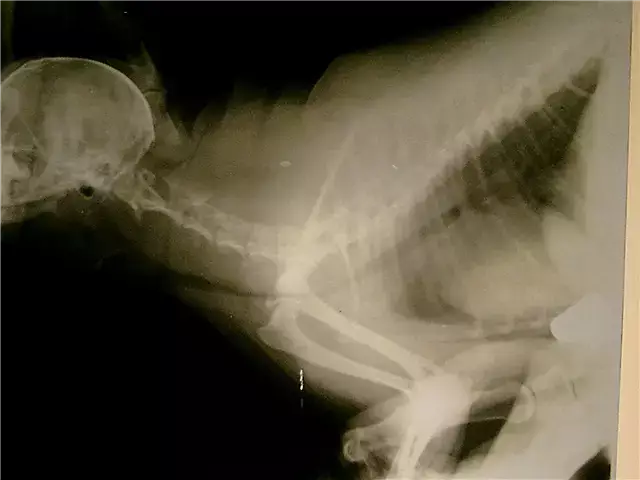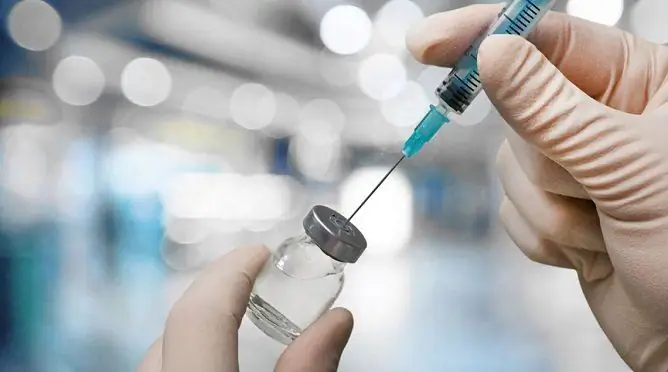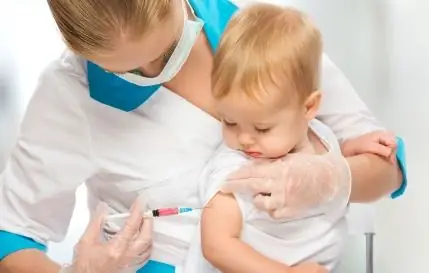- Author Rachel Wainwright [email protected].
- Public 2023-12-15 07:39.
- Last modified 2025-11-02 20:14.
Rabies vaccine
Instructions for use:
- 1. Release form and composition
- 2. Indications for use
- 3. Contraindications
- 4. Method of application and dosage
- 5. Side effects
- 6. Special instructions
- 7. Analogs
- 8. Terms and conditions of storage

Rabies vaccine is a medicine that induces the production of immunity against the rabies virus.
Release form and composition
The rabies vaccine is produced in the form of a lyophilisate for preparation of a solution for injection (hygroscopic white porous mass), 1 ml of which contains a vaccine for the prevention of rabies (specific antigen of the rabies virus, Vnukovo-32 strain) in an amount of 2.5 IU.
Excipients: sucrose, human albumin, gelatin.
In 1 ml ampoules complete with solvent (water for injection).
Indications for use
The rabies vaccine, according to the instructions, is used for:
- Therapeutic and prophylactic immunization of persons whose work is related to the capture and maintenance of neglected animals (in case of contact and bites by rabid, suspected rabies or unknown animals);
- Preventive immunization of people at high risk of rabies infection (hunters, veterinarians, gamekeepers, slaughterhouse workers, foresters, taxidermists).
Contraindications
There are no contraindications for the use of the drug for the purpose of therapeutic and prophylactic immunization.
The use of the antirabies vaccine for prophylactic immunization is contraindicated in:
- Systemic allergic reactions to previous vaccine administration (angioedema, generalized rash);
- Chronic diseases in the stage of decompensation or exacerbation;
- Acute infectious and non-infectious diseases;
- Allergic reactions to antibiotics.
The drug should not be used during pregnancy.
Method of administration and dosage
The rabies vaccine is injected intramuscularly into the deltoid muscle of the shoulder, for children under 5 years old - into the anterolateral surface of the thigh (upper part). The vaccine is not allowed in the gluteal region.
Schemes and doses of immunization for children and adults do not differ.
Before use, the contents of the ampoule are dissolved in 1 ml water for injection. Do not store the dissolved vaccine for more than 5 minutes.
The prophylactic immunization scheme includes:
- Primary immunization - on days 0, 7 and 30, 1 ml;
- The first revaccination after 1 year - 1 ml once;
- Subsequent revaccinations carried out every 3 years - 1 ml once.
Treatment is not prescribed if there is no direct contact with an animal sick with rabies (there is no salivation and damage to the skin).
Treatment with the rabies vaccine, according to the instructions, begins immediately according to the scheme: at 0, 3, 7, 14, 30 and 90 days, 1 ml, in cases:
- Salivation of intact skin;
- Abrasions, single superficial bites or scratches on the trunk and limbs (except for the head, face, neck, genitals, hand, fingers and toes) caused by agricultural and domestic animals.
If the animal remains healthy for 10 days, the treatment is stopped after the third injection. If it is impossible to confirm this, immunization is carried out completely according to the scheme.
Immediate combination treatment consisting of heterologous (equine) rabies immunoglobulin 40 IU / kg, homologous (human) rabies immunoglobulin 20 IU / kg and rabies vaccine on day 0, 3, 7, 14, 30 and 90 days 1 ml, required for:
- Any salivation of the mucous membranes;
- Any bites on the head, genitals, neck, face, hand, fingers and toes;
- Multiple and deep single bites of any localization inflicted by agricultural and domestic animals;
- Any salivation or injury caused by wild carnivores, rodents and bats.
If, by observing the animal for 10 days, it can be confirmed that it is healthy, the treatment is stopped after the third vaccine is given.
Side effects
After the injection of the vaccine, itching, redness, and enlargement of regional lymph nodes may appear at the injection site.
In addition to local side effects, when using the rabies vaccine, it is sometimes possible to develop symptoms such as headache, malaise, weakness, and in some cases neurological disorders occur.
special instructions
After vaccination, you must be under medical supervision for half an hour. With the development of neurological complications, the patient should be urgently hospitalized and symptomatic therapy should be carried out using hyposensitizing and antihistamines.
Vaccination sites should be equipped with anti-shock therapy. At the end of the course of immunotherapy, the patient is given a certificate indicating the type and series of vaccines, the course of vaccinations and a description of post-vaccination reactions.
Rabies care includes topical treatment of scratches, abrasions and wounds as soon as possible, and the administration of the rabies vaccine.
The course of treatment does not depend on the period of appeal of the victim for help, which may be even several months after contact with an unknown, sick or suspected rabies animal.
Glucocorticosteroids and immunosuppressants can lead to the ineffectiveness of vaccine therapy.
The vaccinated person should be informed that during the entire course of vaccination and six months after its completion, the use of any alcoholic beverages is prohibited. It is also recommended to avoid hypothermia, overwork, and overheating.
Vaccinations can be carried out no earlier than 1 month after recovery (remission) from acute infectious and non-infectious diseases, chronic diseases in the stage of decompensation or exacerbation.
Do not use rabies vaccine in ampoules with broken labeling and integrity, as well as in cases of changes in transparency and color, improper storage of the drug and after its expiration date. It is necessary to open the ampoules and carry out the vaccination procedure in compliance with the rules of asepsis.
Analogs
According to the active substance, the analogues of the rabies vaccine are the medicines Kokav, Rabivak-Vnukovo-32, Rabipur.
Terms and conditions of storage
The vaccine is dispensed for medical institutions.
The shelf life is 24 months.
The rabies vaccine is stored and transported at a temperature of 2-8 ° C. Within 2 days, the medication can be transported and stored at temperatures up to 25 ° C.
Information about the drug is generalized, provided for informational purposes only and does not replace the official instructions. Self-medication is hazardous to health!






